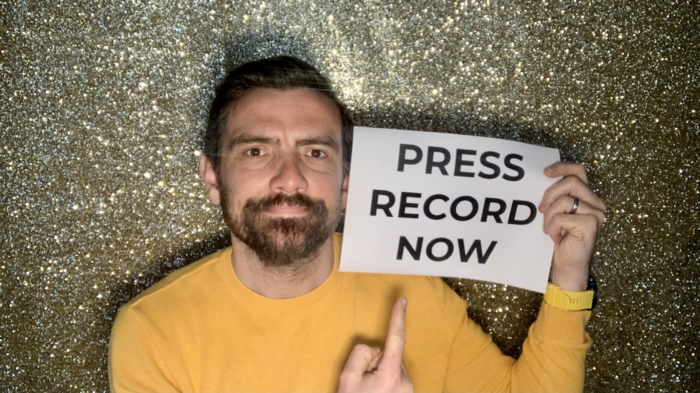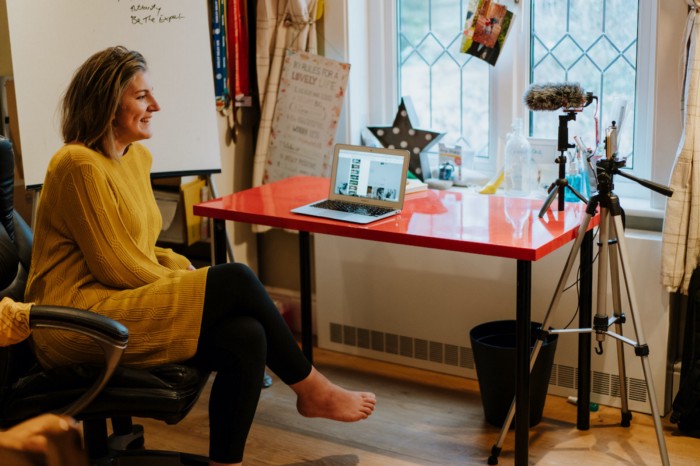Late last year I had the pleasure of chatting with Alan and Emily Braithwaite from Yellow Tuxedo, an online visibility consultancy based in the UK. They run several other businesses too, and have a young family. Busy, busy people!
(You can listen to the interview with Emily and Alan here on my podcast, Reputation Revolution)
We had an interesting and enlightening conversation about what it really takes to build the profile of your business and visibility of your brand in today’s digital age.
We covered search engine optimisation (SEO), why macro-content is king, Yellow Tuxedo’s ‘flywheel’ content marketing strategy, and how vlogging can be a powerful tool in your digital communications armoury.

What is Yellow Tuxedo?
Before we dive into the many and varied informational nuggets around digital visibility, I know you’re probably asking yourself: “What the heck is Yellow Tuxedo?”
This, from Alan and Emily’s their website: “Helping businesses stand out in the crowd… Practically showing you how to maximise your online presence to bring traffic to your website.”
In short, Alan and Emily help individuals and businesses stand out from the crowd, but they do it in a way that’s genuine and human, … and it works.
This dynamic husband-and-wife duo focus on five foundational pieces of their clients’ business: their brand, website, blog, social presence, and their legacy and PR.
Why you need to think like a big brand
Alan and Emily have a lot of experience in running successful businesses, mainly working in outdoor events space. Indeed, it was about eight years ago that they were struck by a realisation.
People were constantly telling them the best way to grow the visibility of your brand online was to post on Instagram once a day, post on Facebook twice a day, and work out where your ideal client is and go and sit with them.
“We used to sit there going, that’s ridiculous. Why would you limit it to that kind of model?” says Alan.
If you want exponential growth, you have to approach brand visibility like big brands do.
“Think about Coca-Cola or Apple…and you type that brand in—or one of their key phrases—into a search engine, you get reams and reams and reams of results for them. So why would we not take that kind of mentality and bring that to the smaller business world? Why would you just want one instance at the top of Google when you could be owning the front page or at least having multiple references to you?”
Alan Braithwaite
But it goes beyond this. People buy from people. This is why the ‘know, like, and trust’ factors are so important when building your small business brand.
And when we talk about online visibility today, people start to know, like, and trust you before they get the chance to meet you in person.
When you start putting out content that people connect with, they are starting their journey in getting to know you and your business.
Time is precious
Your time, your audience’s time – it’s precious. We’re all struggling with it. This is why your content needs to be working for you 24/7.
It’s the flywheel model, says Emily.
You’re at the epicentre and everything around you is spinning and spinning. People in your audience become your advocates. They’re the ones who are coming back to you time and time again, and they are the ones talking about you.
We get that (the flywheel) spinning for us and actually that marketing energy becomes less because it becomes part and parcel of our daily workflow, our routine, and the fact we have a constant audience who know of us.“
Emily Braithwaite
The other model is the sales funnel, which Emily describes as “exhausting”.
In the online world, the default is to run paid ads. And if a potential customer is finding you at the top of your funnel, you want to make sure that you’re getting some return from the customer that comes through it at the end. Then the process starts again.
So you can pay for ads, get 20,000 people to the top of your funnel, and you get a couple of customers at the bottom. There’s nothing wrong with that if that’s what you want to do.
Then Alan poses the question: “But what happens when you stop paying for an advert?”
There’s no traffic to your funnel!
The organic route
If you go down the organic route, your growth can be exponential. You’re building a legacy this way, Alan says.
And, critically, content becomes exciting to create.
We don’t sit there discussing our next sales funnel. We sit there discussing our next content plan.”
Alan Braithwaite
There are so many options when it comes to growing your visibility online, the Braithwaites contend (and I concur!).
You can plan content for video, audio, multi-streaming. Content can be created in all mediums to suit the needs of your audience.
And the whole process does get to be exciting, particularly when you’re focused on producing content that leaves a legacy, that’s authentic.
“We’re putting content out. We’re creating an ecosystem, but we want people to be involved in it”.
Alan Braithwaite
Don’t be afraid to stand out in a crowd
Take a look at Yellow Tuxedo’s digital communications – from their website through to their YouTube videos, live-streams and social posts – and you’ll notice several things: one, the content is very human and accessible … plus everything’s awash with yellow!

And before you ask, you don’t have to choose a bright colour like yellow to stand out! It’s about actually doing what you want, being who you are, and not worrying about what other people think, according to Alan and Emily.
If that means you want to wear yellow all day, every day, then do it!
Although Yellow Tuxedo’s brand goes beyond colour, it does become an instant talking point with their clients and those in their community.
“People on our social media who are out and about during the day say things like, “I saw this (yellow product) in the supermarket, I saw this in this department store, and I just thought of you straight away.”
So regardless of whether your brand is a bright colour or not, it’s more about what it makes people think and feel in terms of your brand.
Macro-content creation
No one else can be you. It genuinely is your unique selling point, but only if you accentuate it.
Video can work wonders here. Just ask Alan and Emily!
During the COVID-19 lockdown in the UK, they decided to publish more content than usual, including a serious vlogging stint during which they put out 100 videos in 100 days. These videos served as the foundation of their “macro-content” creation. More on that in a moment.
According to the Braithwaites, it’s critical that your social media content is optimised in the same way that your SEO and website content needs to be optimised. They all go hand-in-hand.
Because, they say, it’s a really lonely place to be at the top of Google if no one clicks on your link to view your content, in the same way that having great Facebook or Instagram content doesn’t guarantee people will engage with it if it’s not optimised correctly.
It takes planning and thought to research keywords, to understand what your audience needs. But if you do it right and you optimise every piece of content you publish, then being at the top of Google starts to pay off.
To this end, the team at Yellow Tuxedo focus on macro-content creation. In other words, they create “really juicy, amazing content” that has been thought out properly.
And, then it’s about showing up every day with it!
Alan and Emily also recommend creating micro-content from your macro-content, again, as long as it’s optimised thoroughly.
This is what they do, using their flywheel model as a guide:
- They start with a macro piece of content that might launch on a Wednesday
- From that piece of content, they’ll create a blog post, an email, and content for all of their socials.
- Then it goes everywhere, “fully optimised across the world’.
This is what they mean in taking a “big-brand approach”, so that when people do a search on Google, they’re showing up not once, not twice, but for everything like videos, blogs, website, social media … before any paid ads show up.
100 videos in 100 days
Back to the Brainthwaites’ vlogging endeavour.
Last year, Alan and Emily, like many others, suddenly found themselves stuck at home in lockdown, with three kids under the age of six. They had all this time. No place to go, no way of knowing what their business would look like, or how long it would last.
The 100 videos in 100 days vlogging activity came about due to personal reasons. It provided structure to their workday.
“We needed some headspace, we needed to get into work.” – Emily
Their daily videos became a vehicle to talk about what was going on, to show up for their audience at a time when it could have been so easy to go quiet.
“We advised other people to show up more, to still be there, to still be present.”
And while Alan and Emily both agree the vlog was exhausting, they learned good lessons on how you can take one piece of content and create amazing pieces from it, and how being consistent and showing up works.
“We showed up every single day for those three months, we were there, whether it was profound or not. We didn’t script it at all. We would go five minutes, have a morning coffee, and something would come out every single day. Something of how we were feeling, something with our business would happen. And there was always a life lesson.”
Emily Braithwaite
The pair would then spend time optimising the content before distributing it, making sure that no matter what type of content was created, keywords were researched, and well-thought-out titles applied.
It’s being as authentic, approachable, and personable as possible.”
Alan Braithwaite
Sure, as a business, it’s good to publish useful and helpful content that not only provides utility for the audience, but also demonstrates that you’ve got the chops, that you know what you’re doing.
But equally, you also need to put content out there that shows who you really are: that is what really cuts through and connects with your audience.
This is what Alan and Emily from Yellow Tuxedo do better than most.
You can listen to my full interview with Alan and Emily here.
FURTHER READING: Want to build your personal brand using live streaming? Why not create a regular show?


